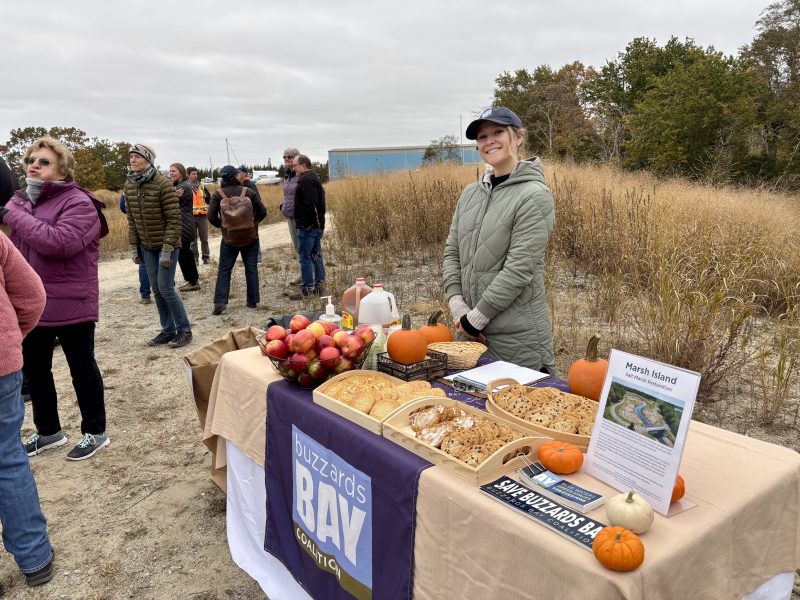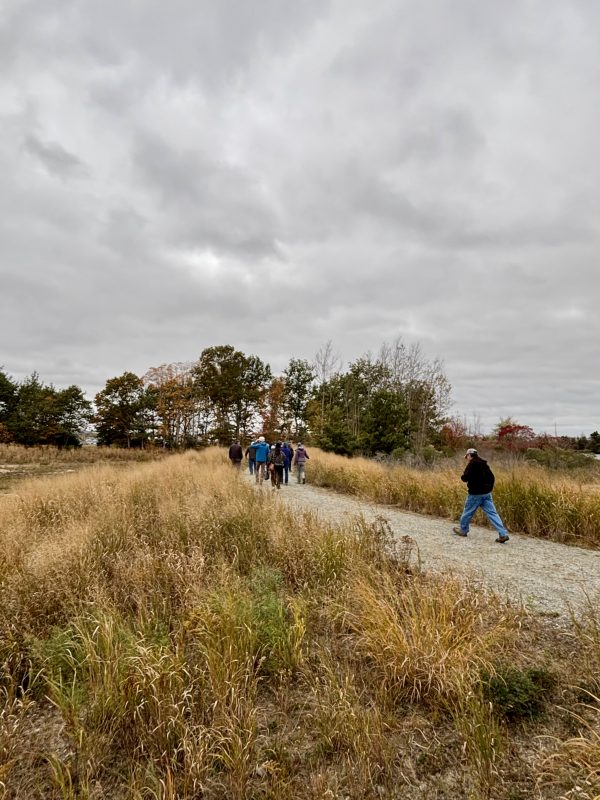Marsh Island Re-Opens for All to Enjoy
Restoration efforts at Marsh Island, which began nearly three years ago, have brought five acres of salt marsh on this peninsula back to life, which had been lost since the late 1930s.
On October 28, the Buzzards Bay Coalition and its partners welcomed local residents and the public to enjoy the paths and great views of the refurbished marsh and the New Bedford skyline across the Harbor in a grand opening at 3:00 pm. People will have the chance to walk the perimeter of the site through the access point at Taber Street. The site features a perimeter trail, scenic overlooks, and all new signage.

Coco Mandle at the Marsh Island opening
“It was a lot of work over a long time, but come on out and take a look,” said Brendan Annett, Buzzards Bay Coalition Vice President of Watershed Protection. “It is really something to see! This beautiful, natural, waterfront area was brought back to life for everyone to enjoy. Birds, wildlife, fish and the green marsh right here in the middle of busy New Bedford Harbor, for the surrounding communities to enjoy.”
Marsh Island is the largest restoration of nature ever on New Bedford Harbor. Located at the site of a former quarry and, later, filled in with dredged sand from the harbor, this area was referred to by locals as “Tin Can Island.”
The Buzzards Bay Coalition and its partners have completed the first half of the salt marsh’s restoration. Engineering design was completed by WSP USA (formerly Louis Berger). Luciano’s Excavation Inc. performed the construction.
The second and final phase will begin in 2030 when the current radio lease ends and the giant towers are removed. This phase of the project will uncover additional sediment from the filled marsh and restore native plants and tidal flow, improving water quality and wildlife habitat, further expanding the restored marsh. Once completed, the restored site will feature an expanded perimeter trail, pedestrian bridge, scenic overlooks, and a trailhead parking area, making this natural gem accessible to the public.

Those attending the re-opening of Marsh Island begin a walk around the property.
During these intervening years, we are opening the northern half of the property to the public so that the public can become an active observer in its entire restoration.
“The Marsh Island Restoration Project is a great example of what we can achieve when we work together,” said Massachusetts Department of Fish & Game’s Division of Ecological Restoration Director Beth Lambert. “By restoring this salt marsh, we’re not only bringing back vital habitat for fish and wildlife but also strengthening the coastline against the impacts of climate change. This project shows that healthy ecosystems are our best defense.”
Marsh Island originally contained extensive salt marsh. Part of the site was then turned into a granite quarry in the 1800s. Between the 1930s and mid-1950s, the site was filled with sediment dredged from New Bedford Harbor navigation channels. The Buzzards Bay Coalition worked with key partners to secure the land for conservation in two parts, in 2002 and 2007, and today, Marsh Island is jointly owned by Buzzards Bay Coalition and the Fairhaven-Acushnet Land Preservation Trust.
“The Headwaters of the Acushnet River were once referred to as the Isle of Marsh. We welcome all Wampanoag communities to celebrate this site and for our neighbors to enjoy this spectacular ecosystem. Grab a pair of binoculars and watch our seasonal visitors upon this newly reclaimed Marsh,” says Cora Peirce, President of Fairhaven Acushnet Land Preservation Trust. “FALPT is thrilled to see this project finally come to fruition with the help of many partners over the last few decades.”
Town officials from Fairhaven and New Bedford attended the opening as did representatives Steve Ouellette and Mark Sylvia. Sylvia grew up nearby and presented a citation from the State House to Buzzards Bay Coalition President Mark Rasmussen at the opening. Staff representing state senator Mark Montigny and US Representative Bill Keating also attended.
The project is a conservation partnership of the New Bedford Harbor Trustee Council, NOAA Restoration Center, Massachusetts Department of Fish & Game’s Division of Ecological Restoration, the National Fish & Wildlife Foundation, and the Fairhaven-Acushnet Land Preservation Trust and others with the Buzzards Bay Coalition.